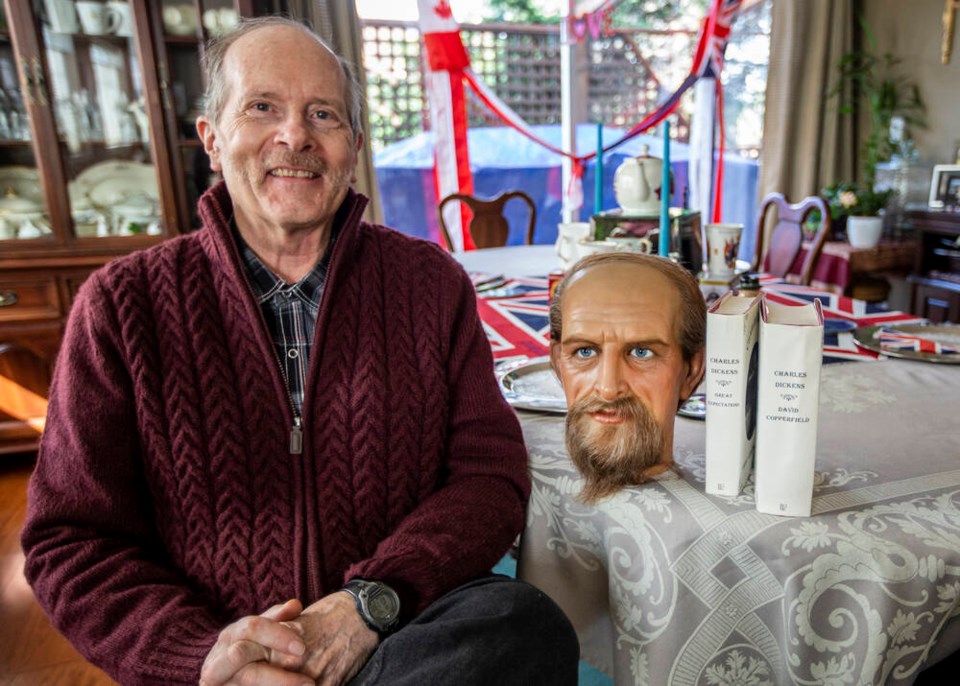Ken Lane keeps hundreds of disembodied heads in his Saanich basement.
He forwarded photos of a couple of them last week — or, at least, pictures of the boxes in which they’re stored — in response to a column in which I appealed for the return of the head of the Queen, which has been missing since someone decapitated a bronze bust in Beacon Hill Park last year.
Lane has his own queen’s head. Two of them, in fact: Elizabeth II and Victoria. He also has the heads of Steve McQueen, the late actor, along with Elvis, JFK assassin Lee Harvey Oswald, Margaret Thatcher, Marilyn Monroe and more than 300 other figures that have been packed away since Lane’s Royal London Wax Museum was chased out of the Inner Harbour’s CPR Steamship building in 2010.
That the collection includes Anne Boleyn, beheaded by Henry VIII, should go without saying.
It’s only the noggins, not the big bits, that Lane keeps in his basement. “The fibreglass bodies don’t need to be in a climate-controlled environment,” he says. “They’re in everyday, run-of-the-mill, rat-free storage.”
The heads, though, need special care. Can’t leave them in the window lest they melt in the sun. Outdoors, they might get sandblasted by wind-blown grit. When the museum was open, a hairdresser would come once a year to shampoo and reset the female figures’ real human hair.
The heads were works of art. It would take something like 60 hours to create them, inserting the hair one strand at a time. Medical glass eyes came from Germany.
It was that sort of detail that helped make the wax museum a big-deal draw in an era when Victoria featured such attractions as Fable Cottage, Undersea Gardens, Sealand of the Pacific and the Olde English Inn.
The museum’s first 60 characters debuted in the Crystal Garden in 1961. They trooped over to the Belleville Street location a decade later.
Did anyone whose likeness was on display ever come in? “Bob Hope. He and John Wayne used to come up fishing all the time,” Lane says. “He said he liked the whole wax museum except for his figure because it was much too young.”
Who would Lane like to add now? Odd as it seems, he thinks TV home-renovation guru Mike Holmes would be a good fit. Lane tilts toward Canadians. (They can be more expensive, though: A 2006 story noted that while mass-produced figures such as U.S. presidents cost $12,000-$15,000, one-offs like Terry Fox or Jean Chrétien could top $20,000.)
“I don’t think Chris Rock would make it,” Lane says. Or, if he did, they would have to move him away from Will Smith.
That’s what they had to do with Prince Charles and Diana after their marriage went sideways. “When the separation was announced, we separated them, and when the divorce was announced, we put a portable wall between them.”
Barack Obama was the last figure added. Kate Middleton, the duchess of Cambridge, was on order when the Royal London Wax Museum lost its lease with the wretched Roundheads at the Provincial Capital Commission, Lane’s landlord. “We cancelled Kate.”
Not much was seen of the figures after that, though out-of-town media would still look to Lane, a former chairman of the local chapter of the Monarchist League of Canada, when a member of the Royal Family had a child or got married or buried a corgi, or whatever. In 2016, when Kate and William visited Victoria, Lanes’ queens made a cameo appearance on Global television, with Squire Barnes sitting in an opera chair upon which Diana — the real one — once perched.
Then, two years ago during Megxit, when Prince Harry and Meghan temporarily took up residence in their North Saanich bolt hole, Lane assembled a brain trust of figures — Elizabeth II, Victoria, Diana, Winston Churchill, Charles Dickens and Capt. Cook — around his living room table to hash out the situation.
It was against that tableau that the New York Times ran a piece suggesting the nature of Victoria was shifting.
“Victoria … has long marketed itself as Canada’s most English city,” the story said. “It is peppered with Tudor Revival architecture, pubs with names like The Churchill and specialty shops selling marmalade jam. Until 1950, its police officers wore bobby-style helmets.”
But that image has faded, the story said. Things change. Some are sad, some are glad.
Lane himself no longer believes his figures’ future lies in the capital. He thinks that with the tourism industry emerging from its two-year slumber, the time is ripe for a sharp operator to scoop them up and put them on display — but not here. The city has lost its vibrancy and lacks good governance, he says. “Victoria’s not the place anymore.”
Best to turn his heads in another direction.



